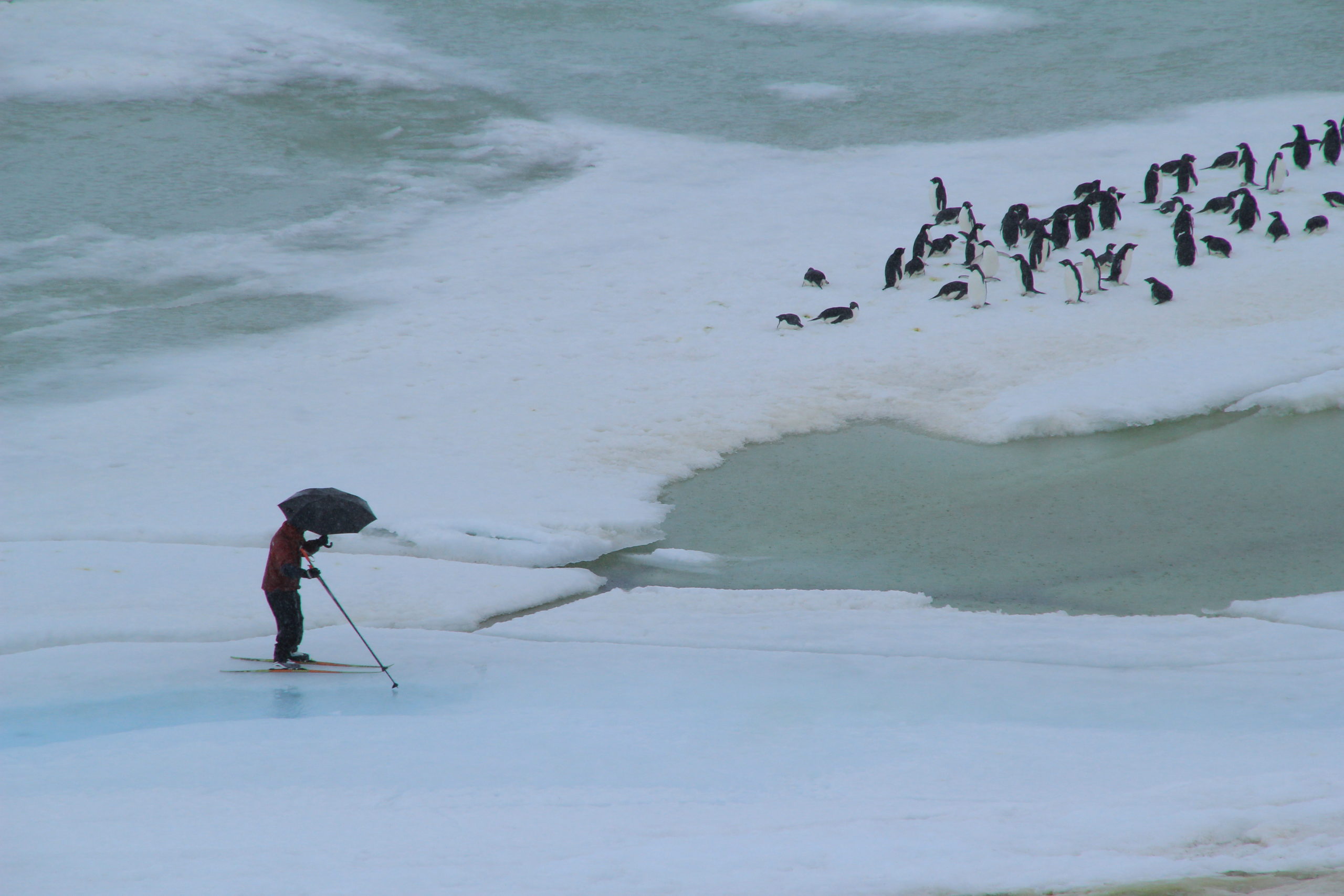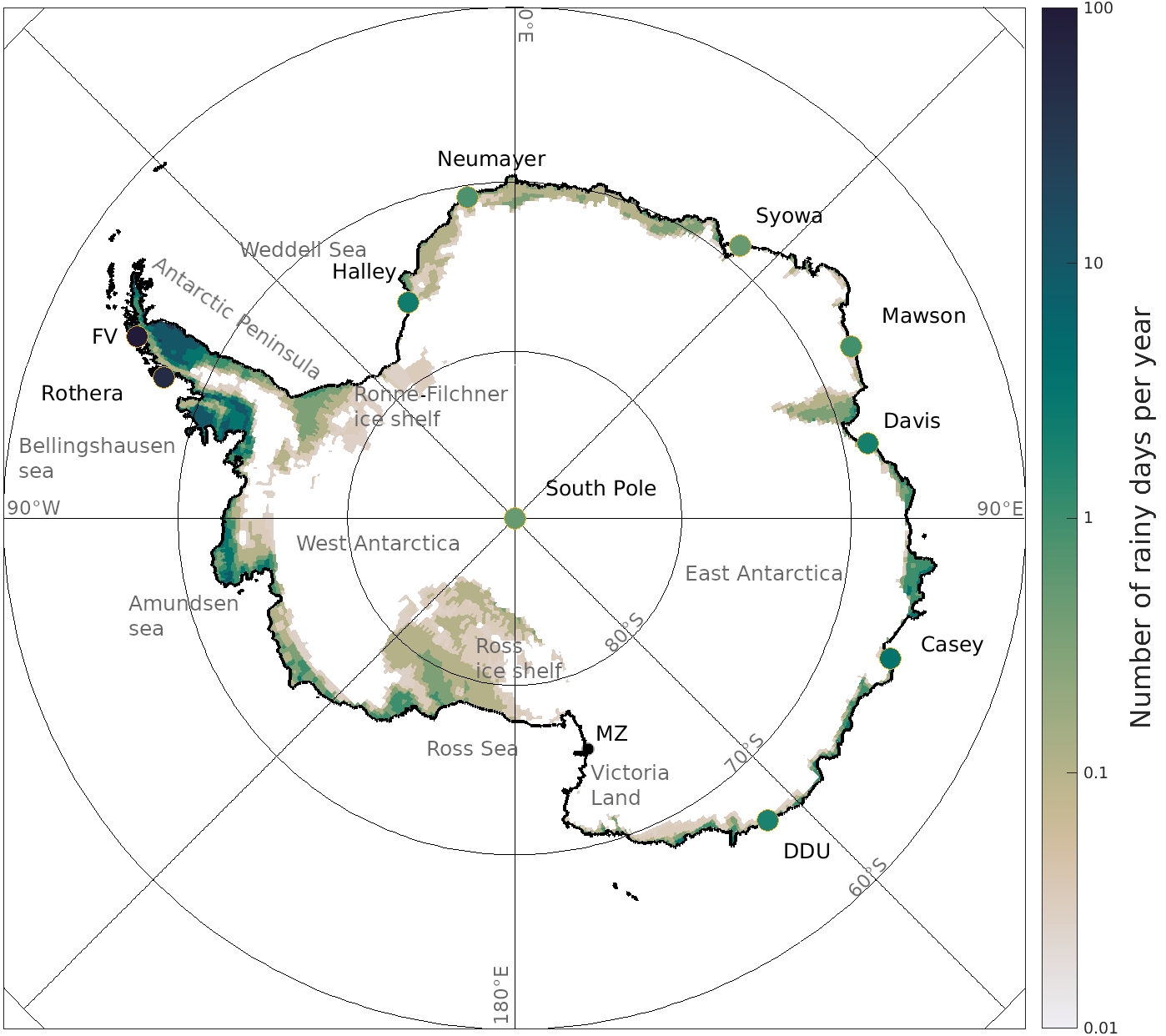Warming and changing weather patterns will affect sea level and penguin colonies
15 April 2021

Rain falls at the Dumont d’Urville Station in the eastern Antarctic coast, New Year’s Day 2014.
Credit: Bruno Jourdain /Nicolas Jourdain / UGA/CNRS/IPEV
AGU press contact:
- Liza Lester, +1 (202) 777-7494, [email protected] (UTC -4 hours)
Contact information for the researchers:
- Étienne Vignon, Laboratoire de Météorologie Dynamique, CNRS, Sorbonne Université, [email protected] (UTC +2 hours)
- Alexis Berne, Environmental Remote Sensing Laboratory, École Polytechnique Fédérale de Lausanne, [email protected] (UTC +2 hours)
WASHINGTON—Rainfall could increase in amount, frequency and intensity over the next 80 years along the coast of Antarctica, a new study predicts.
By 2100, if greenhouse gases continue to be released at a high level, rain might increase by 240% on average across the continent.
The increase in showers could enhance the melting of some of the southern continent’s large ice sheets, which, by consequence, could contribute to rising sea levels around the globe.
Rain can also have dramatic consequences for emperor and Adélie penguin chicks. Since chicks’ feathers aren’t yet waterproof, they can freeze when the wet weather subsequently cools and winds pick up. The breeding season of one of the biggest colonies of Adélie penguin colonies around the Dumont d’Urville research station in southeast Antarctica saw complete failure in the 2013-2014 season due to rainfall.
“We expect not only more frequent rain events but also more intense rain events,” said Etienne Vignon with the French National Center for Scientific Research and Sorbonne University in Paris and first author of the new study published in Geophysical Research Letters, AGU’s journal for high-impact, short-format reports with immediate implications spanning all Earth and space sciences.
Most of the precipitation Antarctica gets is snow. Rain is unusual, and when it does occur, it’s usually on the continent’s coasts. The new study estimated rain falls up to four days per year on average over the coast of eastern Antarctica and more than 50 days on average on the northwestern Antarctic Peninsula.

Where the rain falls: yearly rainy days across Antarctica, on average, from 1979-2017, as reported by ten research stations. The darker blue and green areas experienced more rainy days.
Credit: Vignon et al. (2021) Geophysical Research Letters/AGU
But this may be changing. Vignon and his coauthors set out to measure and predict future rain on the continent after researchers noted an uptick in rain events.
The researchers wanted to learn how common rain was in Antarctica, and how it might be affected by climate change. However, traditional climate tracking systems aren’t good at predicting rainfall due to the extreme weather.
“It’s still a challenge to measure precipitation in Antarctica,” Vignon said.
Vignon and his co-authors gathered information about rain from several decades of observation reports from 10 research stations spread around the continent. They matched these reports, based on ground observations, with what they call atmospheric re-analysis—a combination of model simulations and various kinds of observations from sensors like radiosounding, radar and radiometers at ground level or onboard satellites—to attempt to find a type of signature that indicates rain in the harsh continent.
They came up with a climatology of rainfall occurrence over the past 50 years covering all of Antarctica, beyond the areas immediately surrounding the 10 research stations.
Most of the rain happened along the coasts and the Antarctic Peninsula, the area where penguin colonies come ashore for breeding.
“On average rain almost never occurs on the high plateau because the temperature is too cold,” Vignon said.
Overall, rainfall increased over the peninsula between 1955 and 1999. Surprisingly, the increasing trend reversed from 2000 to 2015, actually decreasing for a period. Vignon said this likely has to do with large natural variability of the climate in this region.
Forecast calls for rain
But the researchers also wanted to see what would happen in the future. They combined this climatology of past rainfall with seven available future climate scenarios outlined in the CMIP6 by the World Climate Research Programme, an international program that helps to coordinate global climate research. The results showed how rainfall might change in the different scenarios through 2100. No matter which scenario they ran, the models showed the same trend.
Increasing rain could have dire consequences for the penguins that nest along the coasts. But it could also impact sea level rise, as rain might enhance the melting and breakup of ice shelves, particularly the Ronne and Ross ice shelves in western Antarctica.
“Rainfall can enhance the melting of the snowpack,” Vignon said.
The findings have relevancy for possible impacts like ice sheet melting and instability, resulting in rising sea levels, according to Richard Bintanja, a professor of climate and Environmental Change at Groningen University in Netherlands who was not involved in this research but who has studied rainfall in the Arctic.
“All and all, that rain will increase in a warming climate should be of no surprise to anyone, but the magnitude at which this occurs on such a cold continent is of interest,” Bintanja said.
###
AGU (www.agu.org) supports 130,000 enthusiasts to experts worldwide in Earth and space sciences. Through broad and inclusive partnerships, we advance discovery and solution science that accelerate knowledge and create solutions that are ethical, unbiased and respectful of communities and their values. Our programs include serving as a scholarly publisher, convening virtual and in-person events and providing career support. We live our values in everything we do, such as our net zero energy renovated building in Washington, D.C. and our Ethics and Equity Center, which fosters a diverse and inclusive geoscience community to ensure responsible conduct.
Notes for Journalists:
This research study will be freely available for 30 days. Download a PDF copy of the paper here. Neither the paper nor this press release is under embargo.
Paper title:
“Present and future rainfall in Antarctica”
Authors:
- Étienne Vignon, corresponding author (Laboratoire de Météorologie Dynamique, CNRS, Sorbonne Université, Paris, France)
- Marie-Laure Roussel (Laboratoire de Météorologie Dynamique, CNRS, Sorbonne Université, Paris, France)
- Irina Gorodetskaya (University of Aveiro, Aveiro, Portugal)
- Christophe Genthon (Laboratoire de Météorologie Dynamique, CNRS, Sorbonne Université, Paris, France)
- Alexis Berne (École Polytechnique Fédérale de Lausanne (EPFL), Lausanne, Switzerland)